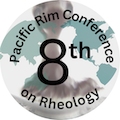Speaker
Description
Abstract:
Radial displacement flows of viscoplastic fluid in a Hele-Shaw cell can give rise to a range of instabilities. Theoretically, the viscoplastic version of the Saffman-Taylor interfacial instability [1] is predicted to occur when the yield-stress fluid is displaced by a Newtonian one. The interface is expected to remain stable, however, if the yield-stress fluid displaces the Newtonian one [2,3].
Experiments using an aqueous suspension of Carbopol show that the Saffman-Taylor instability is observed when the Carbopol is displaced by either air or an immiscible oil, and no instabilities are observed when the displacement is the other way around. However, when water is used in the displacement experiments, other instabilities appear that take the form of localized fractures of the Carbopol over the sections of the interface that are under tension. The fractures arise in both the stable and unstable Saffman-Taylor configurations, leading to a rich range of patterns within the Hele-Shaw cell.
Supported by these experimental observations, we argue that this pattern formation results from the solid-mechanical-like failure of the Carbopol gel. In particular, the fractures result from a reduction of the effective fracture toughness of the suspension when placed in contact with water, also observed in the spreading of Carbopol gravity currents into a shallow layer of water [5].
REFERENCES
1. Saffman P.G., Taylor G.I. The penetration of a fluid into a porous medium or Hele-Shaw cell containing a more viscous liquid, Proc. Roy. Soc. A, 245, (1242) 312-329, 1958.
2. Ball T.V., Balmforth N.J., Dufresne A.P. Viscoplastic fingers and fractures in a Hele-Shaw cell, J. Non-Newton. Fluid Mech., 289, 104492, 2021.
3. Coussot P. Saffman-Taylor instability in yield-stress fluids, J. Fluid Mech., 380, 363-376, 1999.
4. Sayag R., Worster M.G. Instability of radially spreading extensional flows. Part 2: Theoretical analysis, J. Fluid Mech., 881, 739-771, 2019.
5. Ball T.V., Balmforth N.J., Dufresne A.P., Morris S.W. Fracture patterns in viscoplastic gravity currents, J. Fluid Mech., 934, A31, 2022.
About the JNNFM Walters Award Prize.
Bio:
Thomasina Ball is a Warwick Zeeman Lecturer and Leverhulme Early Career Fellow in the Mathematics Institute. Dr. Ball uses theoretical and experimental techniques to understand non-Newtonian fluid dynamics and fluid-structure interactions with applications to geophysical phenomena. She received her MMath in 2015, and PhD from the University of Cambridge, U.K., in 2019. She completed her postdoctoral studies in Department of Mathematics at the University of British Columbia under the supervision of Prof. Neil Balmforth who is jointly awarded the JNNFM Walters Award Prize.

